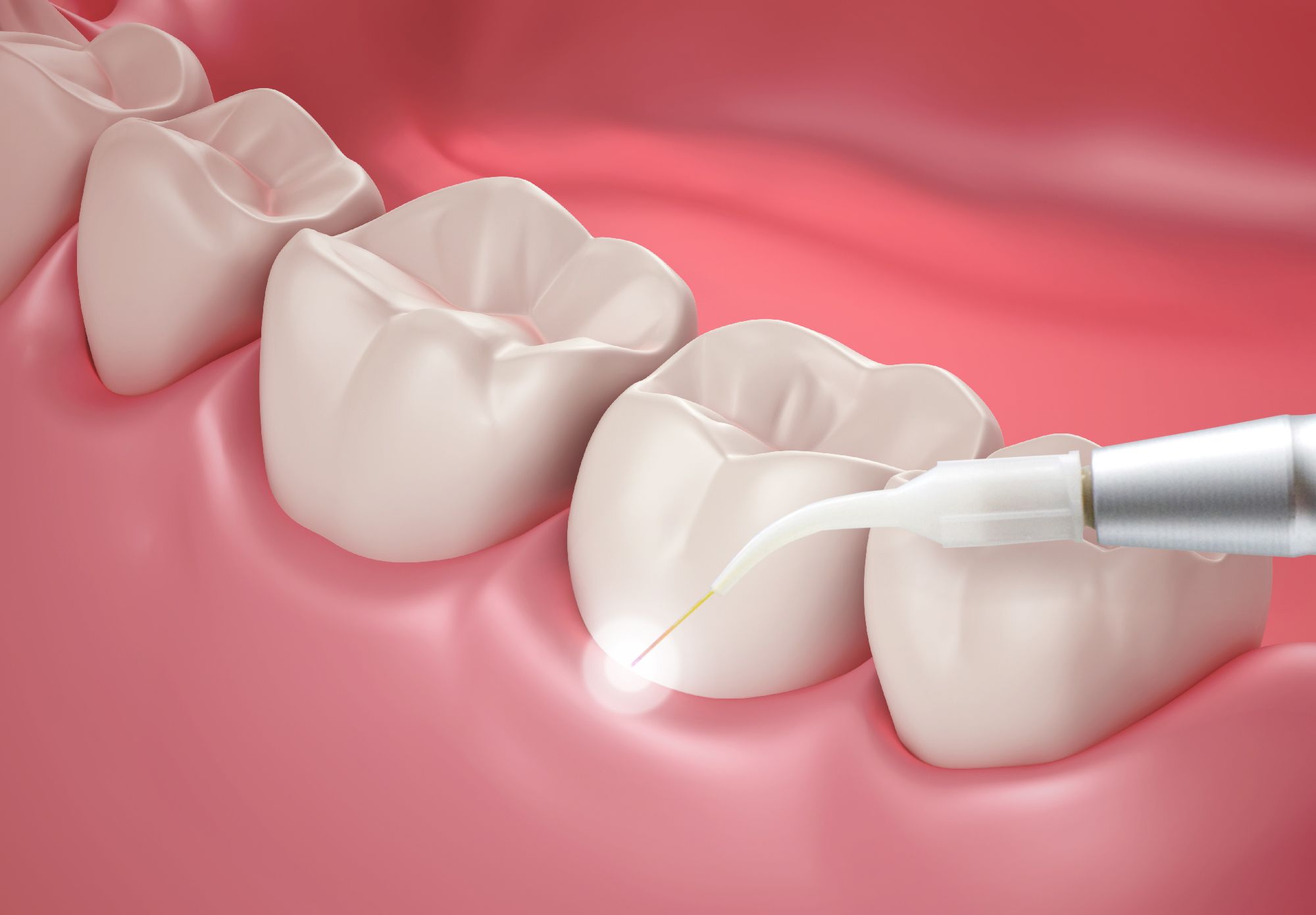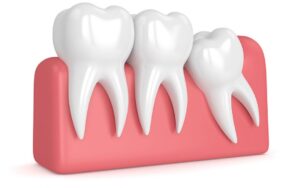Laser Gum Treatment

Laser gum treatment, also known as laser periodontal therapy or laser periodontal treatment, is a modern approach to treating gum disease (periodontal disease) using laser technology.
It involves specialized dental lasers to target and remove infected or diseased gum tissue, bacteria, and tartar buildup from around the teeth and gums.
What are the main benefits of laser gum surgery?
Laser gum surgery offers several benefits compared to traditional gum surgery techniques:
- Minimally invasive: Laser gum surgery is minimally invasive compared to traditional gum surgery methods, which typically involve incisions and sutures. With lasers, there is often less cutting and tissue trauma, resulting in reduced discomfort and faster healing times.
- Reduced discomfort: Laser gum surgery is generally associated with less discomfort during and after the procedure. Patients may experience less pain, swelling, and bleeding compared to traditional surgery, leading to a more comfortable overall experience.
- Faster healing: Because laser gum surgery is less traumatic to the tissues, healing times are often faster compared to traditional surgery. This means less downtime for patients and a quicker return to normal activities.
- Precise treatment: Lasers allow for precise targeting of diseased gum tissue while minimizing damage to surrounding healthy tissue. This precision helps preserve more of the natural gum structure and can lead to better aesthetic outcomes.
- Reduced risk of infection: Laser energy has antibacterial properties, which can help reduce the number of bacteria in the treated area, lowering the risk of post-operative infection.
- Promotes gum tissue regeneration: Laser energy can stimulate the regeneration of healthy gum tissue, promoting better attachment of the gums to the teeth and supporting long-term gum health.
- Less bleeding: Laser gum surgery often results in less bleeding during the procedure due to the cauterizing effect of the laser on blood vessels. This reduces the need for sutures and promotes a cleaner surgical field.
- Improved access: Lasers can access and treat areas of the mouth that may be difficult to reach with traditional surgical instruments, allowing for more comprehensive treatment.
Overall, laser gum surgery offers many advantages over traditional gum surgery, making it an attractive option for patients seeking treatment for gum disease or other gum-related issues.
What are the steps for laser gum treatment?
The specific steps for laser gum treatment may vary slightly depending on the individual patient’s needs and the particular laser technology being used.
Still, here is a list of the typical steps involved in laser gum treatment:
Initial Assessment
The first step is a comprehensive dental examination to assess the patient’s oral health and determine the extent of gum disease or other gum-related issues. This may involve taking dental X-rays and performing periodontal probing to measure the depth of gum pockets.
Treatment Planning
Based on the initial diagnosis, your dentist will develop a treatment plan tailored to your needs. This plan will outline the areas of the mouth that require laser gum treatment and the specific procedures to be performed.
Preparation
Before the laser gum treatment begins, the dental team will prepare you for the procedure. This may involve administering local anesthesia to numb the gums and surrounding tissues to ensure comfort during the treatment.
Laser therapy
Once your are numb and comfortable, your dentist will use a specialized dental laser to perform the gum treatment. The laser energy will be precisely directed at the diseased gum tissue to remove bacteria, tartar buildup, and infected tissue while minimizing damage to healthy surrounding tissue.
Gum debridement
The laser may be used to gently debride the surfaces of the teeth and root surfaces to remove plaque and tartar buildup. This helps to create a clean and smooth surface for the gums to reattach to the teeth.
Gum pocket sterilization
The laser energy can effectively kill bacteria deep within the gum pockets, helping to reduce the risk of infection and promote healing.
Gum tissue reshaping
In some cases, the laser may be used to reshape the gum tissue to improve its appearance or to create a more symmetrical gum line.
Post-operative care
After the laser gum treatment is completed, the dental team will provide instructions for post-operative care. This may include recommendations for oral hygiene practices, dietary restrictions, and any prescribed medications to aid in healing and prevent infection.
Follow-up visits
You will need to schedule follow-up visits with your dental surgeon to monitor healing progress and ensure optimal outcomes. Additional treatments or adjustments may be recommended as needed.
It’s important to note that laser gum treatment is a minimally invasive and relatively comfortable procedure for most patients, but individual experiences may vary. Your dental professional will discuss the specifics of your treatment plan and address any concerns you may have before proceeding with the procedure.
How much does laser gum treatment cost?
The cost of laser gum treatment can vary depending on several factors, including the severity of the gum disease, the extent of treatment needed, the specific type of laser technology used, the location of the dental practice, and any additional procedures or services required.
In general, laser gum treatment tends to be more expensive than traditional gum surgery methods due to the specialized equipment and training required for the procedure.
On average, the cost of laser gum treatment can range from several hundred to several thousand dollars per treatment session.
Some dental insurance plans may cover a portion of the cost of laser gum treatment, particularly if it’s deemed medically necessary to treat gum disease. Check with your insurance provider to determine coverage details and any out-of-pocket expenses.
Many dental practices offer financing options or payment plans to help make laser gum treatment more affordable for patients.
Discuss pricing and payment options with your dental provider during the initial consultation to ensure you understand the costs involved and can make an informed decision about your treatment plan.
How is laser gum treatment compared to traditional gum surgery?
Laser gum treatment and traditional gum surgery are both methods used to treat gum disease (periodontal disease), but they differ in various aspects, including technique, invasiveness, recovery time, and outcomes.
Here’s a comparison between laser gum treatment and traditional gum surgery:
Technique
- Laser Gum Treatment: In laser gum treatment, specialized dental lasers are used to target and remove diseased gum tissue, bacteria, and tartar buildup. The laser energy can effectively kill bacteria and stimulate the regeneration of healthy gum tissue.
- Traditional Gum Surgery: Traditional gum surgery typically involves making incisions in the gums to access and clean the diseased areas, remove infected tissue, and recontour the bone if necessary. Sometimes, gum grafts may be required to restore lost gum tissue.
Invasiveness
- Laser Gum Treatment: Laser gum treatment is generally less invasive than traditional gum surgery. It involves minimal cutting and often eliminates the need for sutures, resulting in less trauma to the gums and surrounding tissues.
- Traditional Gum Surgery: Traditional gum surgery is more invasive and involves making incisions in the gums, which may require sutures for closure. This can result in more tissue trauma and discomfort for the patient.
Recovery Time
- Laser Gum Treatment: Due to its minimally invasive nature, laser gum treatment typically results in faster healing times compared to traditional gum surgery. Patients may experience less post-operative discomfort and can often resume normal activities sooner.
- Traditional Gum Surgery: Recovery from traditional gum surgery may take longer due to the more invasive nature of the procedure. Patients may experience more discomfort, swelling, and bleeding during the recovery period.
Pain and Discomfort
- Laser Gum Treatment: Laser gum treatment is generally associated with less post-operative pain and discomfort compared to traditional gum surgery.
- Traditional Gum Surgery: Traditional gum surgery may cause more post-operative pain and discomfort due to the extent of tissue manipulation and incisions required.
Treatment Outcomes
- Laser Gum Treatment: Laser gum treatment can effectively remove diseased tissue, kill bacteria, and stimulate gum tissue regeneration. It can lead to improved gum health and attachment to the teeth.
- Traditional Gum Surgery: Traditional gum surgery has been used successfully for many years to treat gum disease. It can also lead to improved gum health and attachment to the teeth when performed by an experienced periodontist.
Overall, both laser gum treatment and traditional gum surgery can be effective in treating gum disease, but laser gum treatment offers several advantages in terms of minimally invasive technique, faster recovery times, and reduced discomfort for patients.
FAQ on Laser Gum Treatment
Is laser treatment for gums worth it?
Laser treatment for gums can be worth it for many patients due to its minimally invasive nature, faster recovery times, and reduced discomfort compared to traditional surgery.
How long does laser gum treatment last?
The duration of laser gum treatment’s effectiveness varies depending on individual factors such as oral hygiene habits and the severity of gum disease. Regular dental visits and proper oral care can extend the results.
What are the side effects of laser treatment for gums?
Potential side effects of laser treatment for gums may include temporary sensitivity, swelling, or discomfort. However, these effects are typically mild and resolve quickly.
Is gum lasering painful?
Gum lasering is generally not painful due to the use of local anesthesia. Patients may experience some discomfort during or after the procedure, but it’s usually minimal and manageable.
Fact Checked
Our dedicated team rigorously evaluates every article and guide to ensure the information is factual, up-to-date, and free of bias.
Updated Regularly
We update our articles and reviews regularly to ensure you have access to the latest data in the dental industry.
The content on Dental3DU’s blog is intended for educational purposes only. This information should not be relied upon as professional medical counsel. Be sure to always consult with your dentist about the dangers and benefits of any medication, treatment or procedure.







